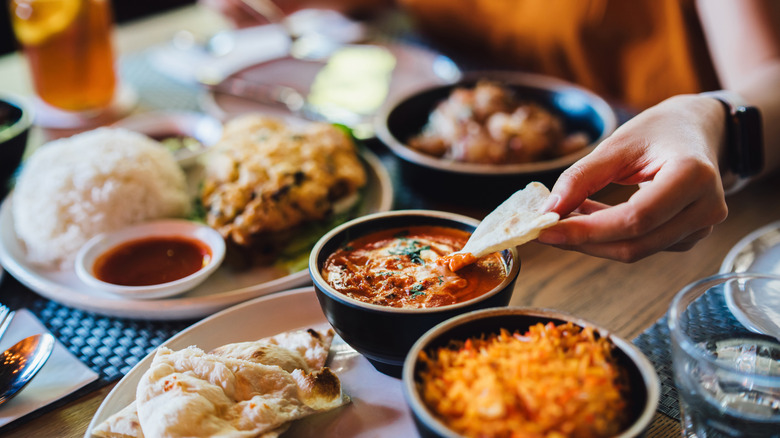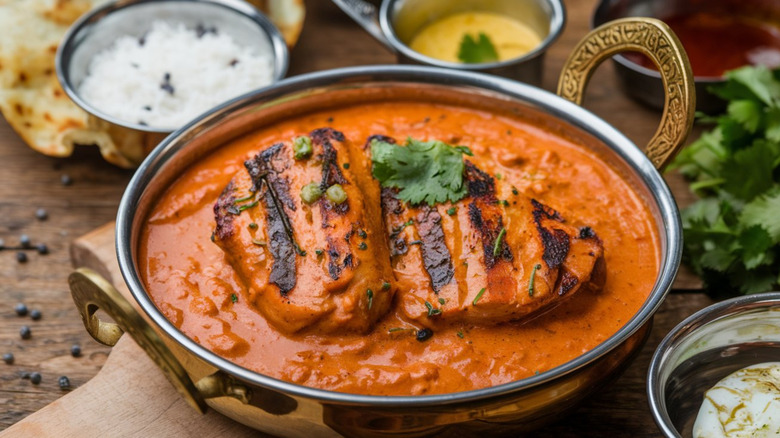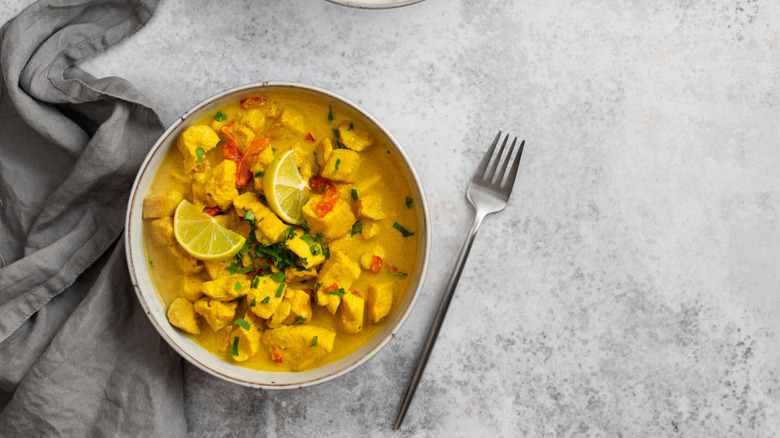What Makes A Curry A Curry
Food is a constantly evolving phenomenon, with certain recipes and ingredients arriving, integrating into culture, and sticking around. Take curry for example — the term's a prevalent mainstay in a broad array of cuisines, and a dish by that name can be found on most Indian or Thai restaurant menus in the U.S. However, though we're familiar with the term, it's difficult to define what actually constitutes a curry.
Curry can refer to a dish, a particular (not actually related) herb, a dried spice mix, a wet gravy, a paste, and even a bouillon cube. As a name coined by European colonizers to describe foreign foods, the term refers to a broad array of spice mixes as well as the dishes made with them. There's no single ingredient that's a common thread, nor is it limited to one cuisine. The British popularized the name as an oversimplification of India's kaleidoscopic variety of foods, so it's usually associated with South Asia. Yet dishes referred to as curries are also commonly consumed in South East Asian, Japanese, Caribbean, African, and British cuisine. The only interconnecting aspect is the imperialist contact, thereby making curry both an expansive and problematic term.
Curry emerged as a foreign simplification of spiced foods
Most historians agree that the word curry likely developed from the Tamil word kari, which means "sauce" and is associated with a spiced sauteed dish prepared in Goa, India. During the 17th century, Portuguese colonizers of the island started calling local stews either caree or caril, and passed down the practice to the British, who changed it to curry. As their imperial influence grew across the entire Indian subcontinent, more and more foods became called curries. Thousands of regional dishes became categorized under the name, without commonality in technique and ingredients.
In order to both simplify and sell the flavors of the area, European traders subsequently invented curry powder. The spice mix packaged the many aromas of the continent into an easily distributed commodity. Indian-inspired curry spices had already reached North America and Europe by the 18th century. Furthermore, Portuguese and British imperial powers also colonized much of the world, and with this came the movement of people and culture. The South Asian diaspora carried spice-laden preparation techniques to areas like Guyana in South America, parts of West, East, and South Africa, as well as many Caribbean islands. Their food blended with local tastes and ingredients, thus involving even more dishes with the catch-all term. And by the 20th century, distinct Thai curries also started going by the name. So move onto the present day, and curry encompasses a global — yet largely indefinite — assortment of foods.
What makes a curry depends on context
Although the term might most commonly be used to describe certain dishes, even this application can be difficult to pin down. Foods called curries abroad often don't carry such a name in local cuisines. In India, they're more likely to use more specific monikers like korma or makhani. Thai curries also became generalized after Western contact, with a later standardization coming by way of the Thai government. Due to the non-official standardization of takeout menus in the U.S., set expectations were developed defining various curries. When we order Thai Panang curry or a red or green curry we expect a specific flavor, as we do when ordering vindaloo or tikka masala at an Indian restaurant.
Just as Mexican American and Tex-Mex dishes may not appear in Mexico, you'll find a much wider variety of cuisine in India and Thailand than you will in the U.S. Similarly, ask for a curry in Japan, and it's a sweet, slightly spicy, roux creation served over rice. Meanwhile head to Jamaica, and a curry involves an aromatic coconut milk mixture simmered with a curry spiced-rubbed chicken. And in the U.K., the term often refers to a thick, curry-powder spiced sauce that's often served on fries. Nowadays, many chefs are striving to use the original traditional name as opposed to the broad curry moniker. Nevertheless, the term remains prevalent in Western food culture,


